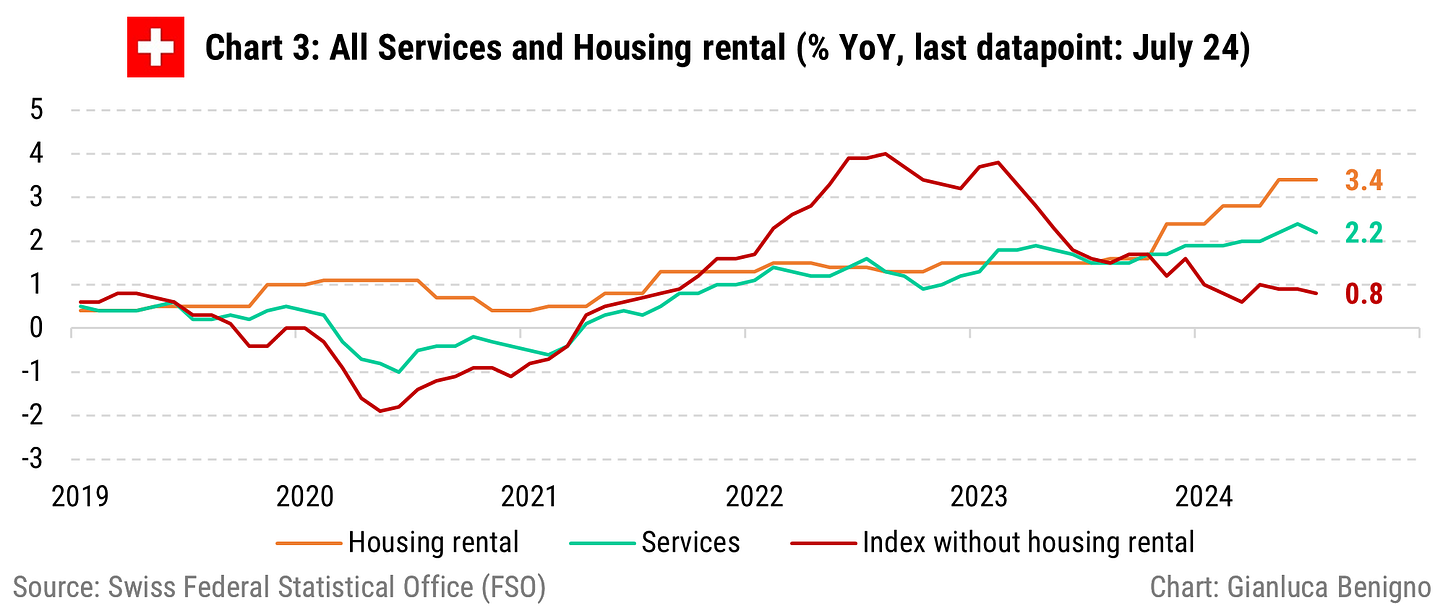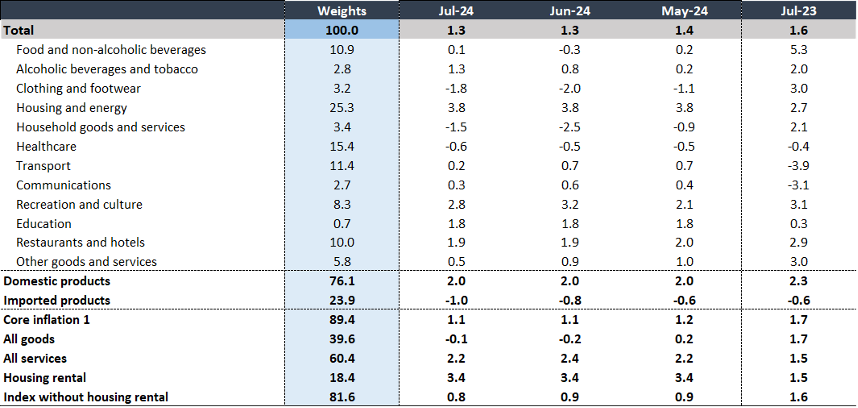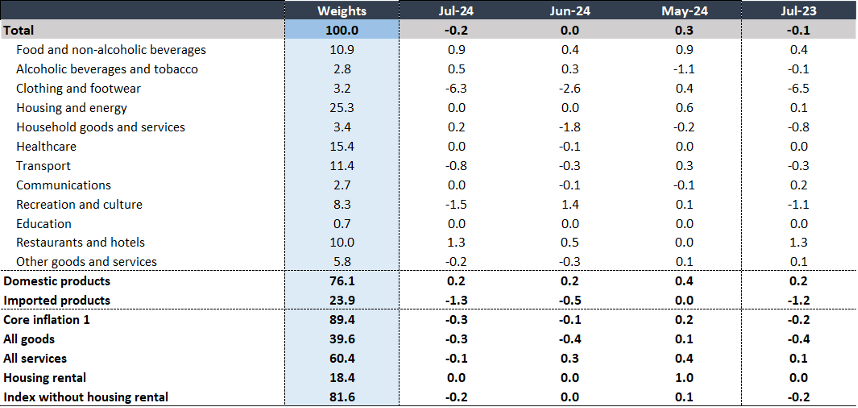Key takeaways:
In July, the Swiss Consumer Price Index (CPI) rose by 1.3% year-over-year (y/y), remaining unchanged from June's figure but below the 1.6% y/y increase recorded in July 2023. On a month-over-month (m/m) basis, the headline CPI decreased by 0.2%, compared to no change in June.
The Core CPI held steady in July compared to June, both at 1.1% y/y. However, it showed a month-over-month decline of 0.3%.
The primary driver of rising prices was the services sector, which experienced a 2.2% y/y increase. In contrast, the goods sector saw a decline for the third time in 2024, with a decrease of 0.1% y/y.
Housing rentals have trended upward since November 2023. In July, the increase was 3.4% y/y, remaining unchanged from June and May (by construction).
These results are consistent with a common dichotomy among major advanced central banks: goods prices are in a deflationary territory while service price inflation is slowly adjusting.
A parallel dichotomy arises in Switzerland by examining import and domestic prices with import prices declining at 1% y/y and domestic prices rising at 2% y/y.
From the SNB perspective, further interest rate cuts would be needed to limit deflationary pressures arising from import prices.
Review of the Inflation Release
Consumer prices rose by 1.3% year-over-year (y/y) in July 2024, unchanged from June. On a month-on-month basis, there was a decrease of 0.2% (versus 0% in June).
Core CPI, which excludes fresh and seasonal products as well as energy and fuels, increased by 1.1% year-over-year (y/y) (Chart 1), remaining unchanged from June's figure. On a month-over-month basis, Core CPI decreased by 0.3%, compared to a 0.1% decline in June. This month’s decrease matches the drop recorded in January, which was the largest since 2020.
Like trends seen in other advanced countries, the services sector, rather than the goods sector, is the main driver of rising prices (Chart 2). In July, services saw a 2.2% y/y increase, down slightly from 2.4% in June. Meanwhile, the goods sector experienced a 0.1% y/y decrease, following a 0.2% y/y decline in June.
Upon examining the more disaggregated data (refer to Tables 1 and 2), it is evident that similar to other advanced economies, housing rentals are the primary driver of inflation (as shown in Chart 3). In Switzerland, this component of the Consumer Price Index (CPI) is adjusted every three months, resulting in a 3.4% year-over-year increase reported in July, which is the same value reported in May and June. Excluding housing rentals, the CPI inflation increased by 0.8% year-over-year.
Another important classification from Switzerland's perspective is the distinction between domestic and imported inflation (see Chart 4). Domestic inflation rose by 2% year-over-year, the same increase observed in May and June. On a monthly basis, domestic inflation increased by 0.2%, the same rate as in June 2024. In contrast, imported inflation decreased by 1% year-over-year, which is lower than the -0.8% recorded in June. On a monthly basis, imported inflation fell by 1.3%, a sharper decline compared to the -0.5% seen in June.
The Swiss Federal Statistical Office also makes available a measure of Harmonized Price Index of Consumer Prices. (The Harmonized Index of Consumer Prices (HICP) is an indicator that the member states of the EU and EFTA calculate based on a harmonized method that allows comparing inflation internationally). The HICP has increased by 1.2% on a year-over-year basis, slightly below the 1.3% recorded in June.
Chart 5: Harmonized Price Index of Consumer Prices (% YoY, last datapoint: July 24)
Overall, the report confirms the recent trend of deflation in goods and imported inflation, alongside persistently higher inflation in the domestic and service components. The recent rate cuts by the Swiss National Bank (SNB) can be interpreted as an effort to limit disinflation by indirectly depreciating the Swiss franc (to limit the deflation from imported inflation), and eventually also working by reducing the inflationary pressure from the housing rental component (by reducing mortgage rates).










